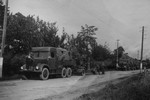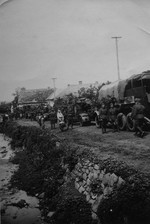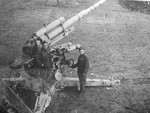Slovak National Uprising
Contributor: C. Peter Chen
ww2dbaseAlthough armed resistance against German and Slovakian collaborator forces had taken place throughout the German occupation, when Soviet troops neared southern Poland in the summer of 1944, resistance forces geared up for a major uprising. On 28 Aug 1944, additional German troops entered Slovakia in response to partisan activities in Slovakia and Romania. On the following day, Slovakian Defense Minister Ferdinand Catlos announced over the radio that German troops had occupied the country; shortly after, at 2000 hours, resistance leader Ján Golian sent out the order to launch the general uprising. The first victory was achieved by the resistance fighters as they captured the city of Banská Bystrica in the morning of 30 Aug, which was quickly made into the headquarters of the resistance leadership. In the confusion of the opening stages of the uprising, however, Slovakian Air Force Colonel Talsky took his aircraft to join the Soviets in southern Poland, thus leaving two divisions of resistance fighters at Presov without support; they were disarmed by the Germans by the following day with minimal resistance. The loss of these two divisions of fighters, who were most recently members of the Eastern Slovakian Army, was particularly devastating as they possessed the heavy weapons needed to counter German regular troops.
ww2dbaseOn 5 Sep 1944, Ján Golian was given the rank of general and the responsibility to direct the uprising. By this time, the official numbers of resistance fighters had grew to 47,000 men, more than double of the strength one week prior. He pushed his men to capture two airfields in eastern Czechoslovakia, which was achieved by 10 Sep, allowing the Soviets to bring in limited supplies and heavy weapons by air. The quantities of Soviet supplies were limited not due to the capacity of aircraft but more so the unwillingness to support a uprising that was not directly controlled by the Soviet Union; furthermore, Soviet General Ivan Konev gave orders to Moscow-controlled partisan groups in the region to avoid coordination with the Slovakian resistance fighters. On 7 Oct, General Rudolf Viest took control of the uprising from Golian, and Golian stepped down to be Viest's deputy.
ww2dbaseBefore long, German troops began to turn the momentum; meanwhile, factions within the resistance movement, which had cooperated awkwardly from the start, began to squabble with each other. On 17 Oct 1944, a German anti-partisan campaign was launched. The operation began with the influx of 35,000 German troops from Hungary, and within days it was apparent that the resistance fighters were no match against hardened German regulars. On 27 Oct, Banská Bystrica was evacuated as the Germans neared. On the following day, Viest sent a message to the Czechoslovakian government-in-exile in Britain that the organized resistance had ended. On 30 Oct, at Banská Bystrica, German SS-General Hermann Höfle and leader of the Slovakian government Jozef Tiso jointly announced the victory over the uprising. On 3 Nov, Viest and Golian were captured in Pohronsky Bukovec, and both of them would be executed before the war's end. On 25 Dec, the small Anglo-American military missions previously sent to aid the Slovak National Uprising were captured by the Germans; some of them would be executed as well.
ww2dbaseSource: Wikipedia
Last Major Update: Jun 2013
Slovak National Uprising Interactive Map
Photographs
 |  |  |  |
Slovak National Uprising Timeline
| 28 Aug 1944 | Additional German troops entered Slovakia in response to partisan activities in Slovakia and Romania, effecting a total occupation. |
| 29 Aug 1944 | Slovakian resistance leader Ján Golian ordered the launch of the planned general uprising. |
| 30 Aug 1944 | Slovakian resistance fighters captured Banská Bystrica, Czechoslovakia. |
| 31 Aug 1944 | Two divisions of Slovakian resistance fighters were disarmed by German troops at Presov, Czechoslovakia. |
| 5 Sep 1944 | Ján Golian was given the rank of general and was given responsibility to direct the Slovak National Uprising. |
| 7 Sep 1944 | A Soviet military mission was established under Major Ivan Skripka in Slovakia to aid the Slovak National Uprising. |
| 1 Oct 1944 | The Slovakian resistance fighters named themselves the Czechoslovakian 1st Army in Slovakia. |
| 7 Oct 1944 | General Rudolf Viest was made the commander of the Slovak National Uprising; previous commander, General Ján Golian, stepped down to become Viest's deputy. |
| 27 Oct 1944 | Slovakian resistance fighters abandoned their headquarters in Banská Bystrica, Czechoslovakia. |
| 28 Oct 1944 | General Rudolf Viest sent a message to the Czechoslovakian government-in-exile in Britain that the organized resistance had ended. |
| 30 Oct 1944 | German SS-General Hermann Höfle and leader of the Slovakian government Jozef Tiso jointly announced the victory over the uprising at Banská Bystrica, Czechoslovakia. |
| 3 Nov 1944 | Slovakian resistance leaders Rudolf Viest and Ján Golian were captured in Pohronsky Bukovec, Czechoslovakia. |
| 25 Dec 1944 | The small US and British military missions previously sent to eastern Czechoslovakia to aid the Slovak National Uprising were captured by the Germans. |
Please consider supporting us on Patreon. Even $1 per month will go a long way! Thank you. Please help us spread the word: Stay updated with WW2DB: |
Visitor Submitted Comments
29 Dec 2014 02:22:47 PM
The location of Pohronský Bukovec on the map is incorrect. The village is nowhere near Rimavská Sobota (which at that time belonged to Hungary), it is between the towns Banská Bystrica and Brezno.
6 Aug 2022 03:00:00 PM
My father, Edward Slansky, who was named Waltzer at the time, was a survivor of Zilina, Novaky and Sered. He was born in Sered. His brother and grandmother were sent to a death camp. He was released as a useful Jew from Zilina. He escaped the Novaky labour camp during the Slovak uprising and joined the partisans. His parents, Emil and Irene lived out the rest of the war in the woods after being freed at Novaky. My father fought as a Partisan. He was captured by the SS after being turned in by a local. He ended up in Sered concentration camp. He was being sent by train from sered to a death camp or concentration camp when he and a friend escaped from the train and came to the advancing Soviets army.
He died a Canadian citizen almost 30 years about. I am interested to know if anyone alive has any knowledge of him or the actions and circumstances of which he was a part.
All visitor submitted comments are opinions of those making the submissions and do not reflect views of WW2DB.
» Czechoslovakia
- » 1,167 biographies
- » 337 events
- » 44,601 timeline entries
- » 1,243 ships
- » 350 aircraft models
- » 207 vehicle models
- » 376 weapon models
- » 123 historical documents
- » 261 facilities
- » 470 book reviews
- » 28,520 photos
- » 367 maps
General Douglas MacArthur at Leyte, 17 Oct 1944
Please consider supporting us on Patreon. Even $1 a month will go a long way. Thank you!
Or, please support us by purchasing some WW2DB merchandise at TeeSpring, Thank you!
7 Nov 2014 07:46:02 AM
this sucked bad